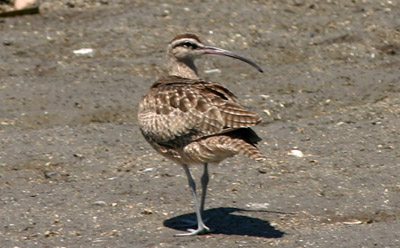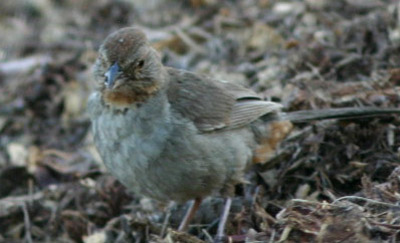The first time I beheld the awesome bounty of Oakland’s Arrowhead Marsh, that initial encounter with a wonderland of waterfowl, waders, and West Coast gulls, was some time before noon in March of 2006. Though my surprise then at Arrowhead’s amazing productivity could surely be described as pleasant, my surprise this time upon learning that summer presents a very different face from spring in these parts definitely could not. What happened to all the birds?

Whimbrel
As I mentioned in my Cliff House report, my first official act of birding on touching down at Oakland International Airport was to drop in at Arrowhead. Early afternoon on a real scorcher of a day offered much less in the way of massive mixed flocks of waterfowl than I was used to here. The mud flats weren’t exactly thronging with shorebirds either. No matter, though, because in the span of a few minutes, I picked out my target birds. First came the awkward yet elegant Black-necked Stilt, an unmistakably beautiful shorebird. This was my first time enjoying this bird, so the fact that stilts were second only to Brown Pelican, another target, was a big bonus.
The stilts were hobnobbing with various shorebirds, these ones tall and drab. The Willets, Western of course, I expected, and the Marbled Godwit was another species I’d seen here before. What I wasn’t prepared for were the Whimbrel. Dappled brown like so many other shorebirds, whimbrels are distinguished by their impressive, gently-hooked bills. I pulled myself away from these life birds to track down a creamsicle-colored American Avocet, this bird’s needle bill decurved rather than curved. With that, I was off. The cool Pacific Coast beckoned and I thought an evening excursion would offer better birding. Talk about a tactical error.
When I arrived between 6:30 and 7:00 PM two days later, I observed with grave disappointment that the mudflats were gone, swallowed by high tide. No mudflats means, of course, no shorebirds, but I didn’t have to wonder long where they all went. As the sun slowly slipped from the sky, great flocks of assorted shorebirds flew to isolated portions of Arrowhead’s interior marshes, ready to bed down for the night. The birds I’d already seen here, stilts and godwits, willets and whimbrels, were easiest to identify, but smaller species also filled these flocks. So much for shorebirding.
Turning my attention to waterfowl, I noted that the brilliant diversity of ducks, geese, and grebes noted in March had dwindled down to a flock of Mallards accompanied by a lone Pied-billed Grebe. The variety of gulls was gone too, with only Western making the scene. Terns picked up the seabird slack, represented by Forster’s and possibly Least. Other birds included Turkey Vultures, Great and Snowy Egrets, Barn and Cliff Swallows, Black Phoebes, House Finches, Northern Mockingbirds, Mourning Doves, California Towhees, and Bushtits. The dominant sparrow was Song, but I pulled out at least one that looked to be a Lincoln’s Sparrow.

California Towhee
On a final note, I’m almost certain that I also spotted the elusive California Clapper Rail, a specialty of Arrowhead Marsh. The bird was bullying a small flock of stilts in the distance, shoving them around in its quest for the food underfoot. Unfortunately, a few willets were nearby, and wouldn’t you know it but they exhibited similar behavior and form. I never knew how much a willet could look like a rail until that moment, at least from far away. Their mimicry leaves me with enough doubt that I’m going to take a pass on that rail and hope for better luck, or at least better views, next time!













Leave a Comment